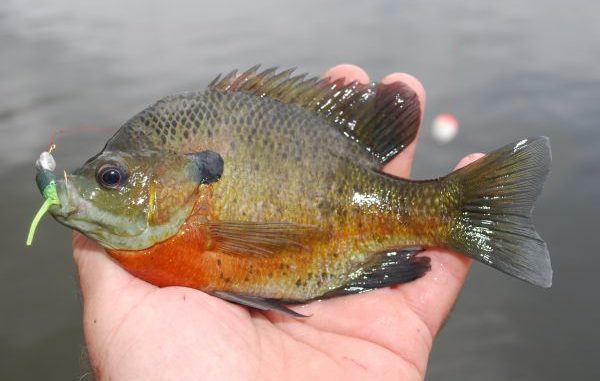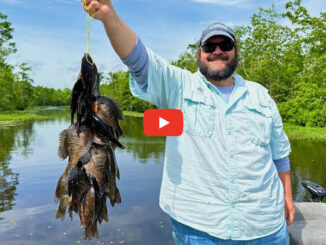
This feisty species is definitely the backbone of the bream fishery. It gets big — for a bream —at 10 inches, and during its summer-long spawning season forms dense beds of nests. Like all members of the sunfish family, the nest is formed by the male and guarded from before spawning until the young have hatched and left the beds.
Bluegills are different than their relatives, however, in that the males don’t leave the nest sites after the young hatch. They will attempt to lure other ripe females to the nests after the young of the first — or second — or even third spawn have left.
Males and females appear dramatically different in coloration. Females will have six or seven broad, vertical, olive-colored bars set on a yellow background of varying intensity. Females are also substantially smaller than males
Spawning males are truly beautiful creatures. They have a head profile so domed that their “faces” look creased. Most noticeable are their unmistakable copper-colored bellies and the bright blue-green coloration of the lower gill cover and the lower jaw. Their overall body color is dominated by olive hues in varying shades. Body, belly and jaw/gill cover color will vary with the color of the water the fish came from.
The darkest fish will appear almost black, and invariably come from clear water stained darkly with tannic acid (swamp water). Fish from muddy water will show the least-intense colors.
After spawning season ends in September, colors gradually fade, with the copper belly turning to yellow. By the dead of winter, males are nearly as drab as females, but are still easily recognizable by their prominant foreheads.
All bluegill —male and female, summer or winter — display a black flap that projects backward from each gill cover, an easy key to recognizing the species.
Bluegills are found in rivers and bayous, but reach their greatest densities in natural and man-made lakes. They also thrive in small man-made ponds, where they are stocked in combination with largemouth bass.
Bluegills are not only flexible in habitat but in diet, as well. Dedicated insect-eaters, they feed on both aquatic insects and terrestrial bugs that fall into the water. Few have a chance to sink before a bluegill sucks them off the surface. Their tendency to surface-feed makes them great game for fly-rodders using insect imitations or poppers.
They will also dine on any type of live worm or grub, grass or river shrimp, very small crawfish and small minnows. Their penchant for eating minnows makes them suckers for small beetle spins. Tube jigs, which imitate shrimp, are also deadly on bluegills.

